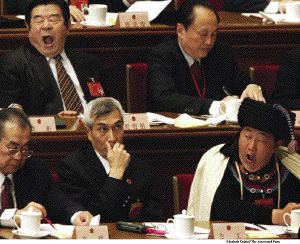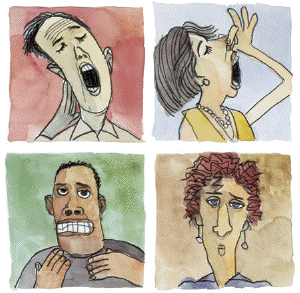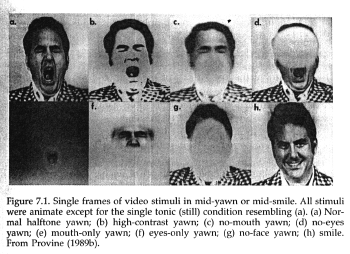 - Extract : Unconscious Control
-
- You cannot yawn on command. This observation
is the best evidence of yawning's unconscious
control. Yawns occur either spontaneously or as
a contagious response to an observed yawn.
Intense self-awareness, as when you are being
observed or even suspect that you may be
observed, inhibits yawning. I already had
experimental evidence of this inhibition when I
began studying yawning contagion, providing the
rationale for the use of self-report in
experiments. As my yawning studies attracted
attention (the popular media have a voracious
appetite for stories on this topic), I had the
experience of seeing the inhibition play
out.
-
- A television news-magazine crew turned up
one day to tape a segment. Against my advice,
the show's producer set out to recreate my
experiment in which one-half of a large lecture
class read an article about yawning while the
other half read a control passage about
hiccuping. Normally the effect of the yawning
article is robust, and it has been used as a
demonstration of contagion in classes at other
universities. As I predicted, the demonstration
did not survive up-close-and-personal scrutiny
by a national network television crew. With the
cameras rolling as the students read, only a
tiny fraction of the usual amount of yawning was
observed.
-
- The video crew performed an unintentional
but informative variant of my original research
demonstrating the powerful effect of social
inhibition on yawning. Even highly motivated and
prolific yawners who volunteered to be on
national television stopped yawning when placed
before the camera. It is notable that the social
inhibition of yawning occurred unconsciously and
was not the voluntary effort of the yawner to
suppress a rude or inappropriate act. A socially
significant act can be either produced or
inhibited by unconscious processes. Scrutiny
also inhibits hiccuping, an act that is also
unconscious but is not contagious.
-
- When piano students in my wife's home studio
start hiccuping, she signals me to bring my tape
recorder into the studio to record their sounds.
In all nine cases where we have used this
technique, my appearancewith recorder and
microphone has been followed almost immediately
by an end to the hiccuping. I've thus discovered
an effective treatment for the hiccups while
finding further evidence for the social
inhibition of an unconsciously controlled act.
When the ancient and the new, the unconscious
and the conscious compete for the brain's
channel of expression, the more modern,
conscious mechanism dominates, suppressing its
older, unconscious rival.
-
- Conclusion
-
- Too little is known for this article to end
with a dazzling intellectual flourish and a
Grand Unified Theory of Yawning. It is customary
at this point, though, to suggest a need for
further study, and indeed I see much potentia in
using yawning to develop and test theories of
mind and to better understand certain neuro- and
psychopathologies. Here I have attempted to
describe the yawn, when we do it and its promise
for study, without speculating about
function.
-
- Yawning appeared very early in vertebrate
history, with contagiousness evolving much
later. Yawning has many consequences, including
opening of the eustachian tube, tearing,
inflating the lungs, stretching and signaling
drowsiness, but these may be incidental to its
primal function which may something as
unanticipated as sculpting the articulation of
the gaping jaw during embryonic development.
Selecting a single function from the many
options may be an unrealistic goal. However,
reviewing the disparate facts, I'm impressed
that yawning is associated with the change of
behavioral state wakefulness to sleep, sleep to
wakefulness, alertness to boredom, threshold of
attack, sexual arousal, switching from one kind
of activity to another.
-
- Yawning is a vigorous, widespread act that
may stir up our physiology and facilitate these
transitions, with the motor act becoming the
stimulus for the more recently evolved
contagious response. Consider the Bakairi people
of central Brazil as observed by their first
European visitor, 19th-century ethnologist Karl
von den Steinen. Irenäus Eibl-Eibesfeldt
recalls in his 1975 book Ethology that Steinen
reported: "If they seemed to have had enough of
all the talk, they began to yawn unabashedly and
without placing their hands before their mouths.
That the pleasant reflex was contagious could
not be denied. One after the other got up and
left until I remained with my dujour.
-
- Among all members of our species, the chain
reaction of contagious yawning synchronizes the
behavioral as well as the physiological state
our tribe. Yawning is a reminder that ancient
and unconscious behavior lurks beneath the
veneer of culture, rationality and language,
continuing to influence our lives.
 - Figure 2(Tom Dunne). The
physiological requirements for a yawn can be
determined with a self-experiment. A normal yawn
(top left) involves gaping jaws, a deep breath
and a shorter exhalation. If you pinch your nose
when you begin to yawn, you will find that you
yawn quite normally; the nostrils are not
necessary for the deep inhalation. A
clenched-teeth yawn, by contrast, is impossible,
revealing the yawn to be a complex motor program
requiring gaping jaws. Finally, if you try a
"nose yawn"Ñinhaling only through the
noseÑyou will find that inhalation
through the mouth is an essential component of
the yawn.
-
-

|





